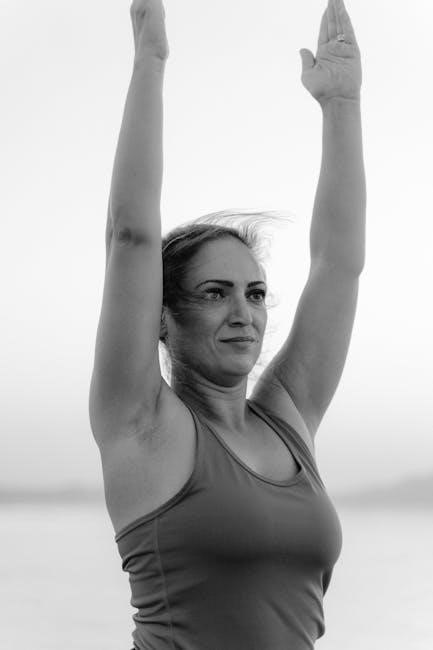Quadricep tendonitis is inflammation of the quadriceps tendon, often caused by overuse or repetitive strain. It commonly affects athletes and individuals with active lifestyles, leading to pain and limited mobility. Proper management and targeted exercises are essential to alleviate symptoms and prevent further complications.
1.1 Understanding the Condition
Quadricep tendonitis is an inflammation of the quadriceps tendon, often caused by overuse or repetitive strain. It typically affects individuals with active lifestyles, such as athletes or those engaging in frequent jumping or running. Symptoms include pain above the knee, swelling, and tenderness. If left untreated, it can lead to chronic pain and limited mobility. Proper management involves a combination of rest, targeted exercises, and physical therapy to reduce inflammation and strengthen the tendon. Early intervention is crucial to prevent further complications and ensure a full recovery. Understanding the condition is the first step toward effective treatment and long-term relief.
Symptoms and Diagnosis
Symptoms include pain above the knee, swelling, and tenderness. Diagnosis involves physical exams, patient history, and imaging like MRI or ultrasound to confirm tendon inflammation.
2.1 Common Symptoms and Diagnostic Methods
Common symptoms of quadricep tendonitis include pain above the knee, swelling, tenderness, and stiffness, especially after activity. Patients may experience limited mobility or aching sensations. Diagnosis involves physical exams to assess pain locations and muscle strength. Imaging tests like MRI or ultrasound are used to confirm tendon inflammation or tears. A thorough patient history helps identify repetitive strain or overuse patterns. Early diagnosis is crucial for effective treatment and preventing further damage. Proper evaluation ensures tailored exercise plans can be developed to address the condition effectively.

Exercises to Avoid
Deep squats and lunges should be avoided, as they involve significant knee flexion, which can exacerbate quadricep tendonitis by increasing pain and inflammation.
3.1 Deep Squats and Lunges
Deep squats and lunges are high-risk exercises for individuals with quadricep tendonitis. These movements involve deep knee flexion, which can strain the quadriceps tendon, leading to increased pain and inflammation. Avoiding such exercises is crucial during the recovery phase to prevent aggravating the condition. Instead, focus on low-impact activities that strengthen the surrounding muscles without putting excessive stress on the tendon. This approach helps promote healing and reduces the likelihood of further injury. Always consult a healthcare professional before resuming any exercise routine.

Best Strengthening Exercises
Leg presses and leg extensions are effective for strengthening the quadriceps without excessive tendon strain. These exercises help isolate the muscle, promoting strength and healing. Start with light weights and gradually increase intensity to avoid overloading the tendon. Incorporate cross-training activities like cycling or swimming to support recovery while minimizing knee stress.
4.1 Leg Presses and Leg Extensions
Leg presses and leg extensions are highly recommended for strengthening the quadriceps while minimizing strain on the tendon. These exercises isolate the muscle, promoting strength and stability without overloading the tendon. Start with light weights and progress gradually to avoid exacerbating the condition. Leg extensions, in particular, target the quadriceps effectively and can be modified to suit different fitness levels. Incorporating these exercises into your routine helps improve knee function and reduces the risk of further injury. Consistency and proper form are key to achieving optimal results and supporting the healing process.
Stretching and Mobility Exercises
Stretching and mobility exercises are crucial for improving flexibility and reducing stiffness in the quadriceps. Gentle knee mobilizations and standing quadriceps stretches are highly effective; These exercises promote healing by enhancing blood flow and relieving tension in the tendon, ensuring optimal recovery and preventing future episodes. Consistency is key to achieving long-term benefits and maintaining healthy knee function.

5.1 Standing Quadriceps Stretch
The standing quadriceps stretch is a highly effective exercise for alleviating tightness and improving flexibility in the quadriceps tendon. To perform this stretch, stand tall and hold onto a chair or wall for balance. Bend one knee, gently pulling your foot toward your buttocks until a mild stretch is felt in the front of your thigh. Maintain the stretch for 20-30 seconds and repeat 2-3 times on each side. This exercise helps reduce stiffness, promotes healing, and enhances mobility. It is particularly beneficial when done consistently, preferably after strengthening exercises or activities that may strain the tendon. Regular practice ensures optimal recovery and prevents future episodes.

Preventing Future Episodes
Preventing quadricep tendonitis involves avoiding deep squats and lunges, incorporating low-impact exercises, and ensuring proper warm-up and cool-down routines before and after physical activities.
For long-term prevention of quadricep tendonitis, focus on consistent strengthening and stretching routines. Incorporate low-impact exercises like swimming or cycling to reduce stress on the knee. Gradually increase workout intensity to avoid overloading the tendon. Proper warm-up and cool-down routines are essential, ensuring muscles are prepared for activity. Strengthening core and hip muscles can improve overall knee stability. Additionally, using supportive braces or tapes during high-impact activities may help. Regular physical therapy check-ups can monitor progress and address any early signs of strain, promoting sustained tendon health and functionality. Consistency is key to preventing future episodes effectively. Downloadable PDF guides provide structured exercise plans for quadricep tendonitis, offering evidence-based routines to promote recovery and long-term tendon health. These resources are ideal for both home and professional use. When seeking exercise plans for quadricep tendonitis, it’s crucial to rely on evidence-based resources. Downloadable PDF guides often include structured routines tailored to promote recovery and strength. Look for guides endorsed by physical therapists or medical professionals, as they ensure exercises are safe and effective. Many resources include detailed instructions, progression plans, and safety tips to avoid worsening the condition. Additionally, some guides offer customizable programs to suit individual needs and fitness levels. Always verify the credibility of the source to ensure the exercises align with your specific condition and goals. This helps maximize recovery and long-term tendon health. If symptoms persist or worsen despite rest and exercise, consult a healthcare provider or physical therapist. They can offer tailored treatment plans and advanced therapies to aid recovery.6.1 Tips for Long-Term Prevention

Downloadable PDF Guides and Resources

7.1 Finding Reliable Exercise Plans
When to Seek Professional Help
8.1 Importance of Physical Therapy
Physical therapy is crucial for managing quadricep tendonitis, offering personalized exercise plans and advanced techniques. Therapists assess the injury’s severity and create tailored programs to improve strength, flexibility, and mobility. They focus on reducing pain and inflammation while preventing future episodes. Techniques like eccentric exercises, soft tissue mobilization, and bracing are often employed. Early intervention can prevent the condition from progressing and ensure a full recovery. Regular sessions with a physical therapist are essential for achieving long-term relief and maintaining knee health.
A structured approach to managing quadricep tendonitis involves strengthening, stretching, and avoiding aggravating activities. Consistent exercise and professional guidance can significantly improve knee function and overall recovery.
9.1 Summary and Next Steps
Effective management of quadricep tendonitis requires a balanced approach, combining rest, targeted exercises, and lifestyle adjustments. Avoiding deep squats and lunges is crucial to prevent further strain. Incorporating strengthening exercises like leg presses and extensions, along with standing quadriceps stretches, can enhance recovery. Preventative measures, such as proper warm-ups and cross-training, are essential for long-term knee health. For personalized guidance, consider downloading reliable PDF exercise plans or consulting a physical therapist to tailor a program to your needs. Consistency and patience are key to achieving optimal results and avoiding future episodes.
